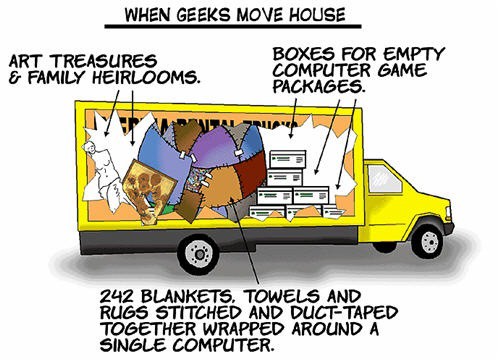Easing the Transition to Your New Home
Use the right boxes, and pack them carefully
Professional moving companies use only sturdy, reinforced cartons.
The boxes you can get at your neighborhood supermarket or liquor store
might be free, but they are not nearly as strong or padded, and so
can’t shield your valuables as well from harm in transit.
Use sheets, blankets, pillows and towels to separate pictures and
other fragile objects from each other and the sides of the carton.
Pack plates and glass objects vertically, rather than flat and
stacked.
Be sure to point out to your mover the boxes in which you’ve packed
fragile items, especially if those items are exceptionally valuable.
The mover will advise you whether those valuables need to be repacked
in sturdier, more appropriate boxes.

The heavier the item, the smaller the box it should occupy. A good
rule of thumb is if you can’t lift the carton easily, it’s too heavy.
Label your boxes, especially the one containing sheets and towels,
so you can find everything you need the first night in your new home.
For your family’s safety and comfort
Teach your children your new address. Let them practice writing it on
packed cartons. You can lighten your load and reduce any storage space
you need to rent by hosting a garage or yard sale.
Fill two “OPEN ME FIRST” cartons containing snacks, instant coffee or
tea bags, soap, toilet paper, toothpaste and brushes, medicine and
toiletry items (make sure caps are tightly secured), flashlight,
screwdriver, pliers, can opener, paper plates, cups and utensils, a
pan or two, paper towels, and any other items your family can’t do
without. Ask your van foreman to load one of these boxes, so that
it will be unloaded at your new home first. Why the second box? In
case the movers are delayed getting to your house on the day of the
move.
Keep your pets out of packing boxes and away from all the activity on
moving day.

Let all your electrical gadgets return to room temperature before
plugging them in.
Since you may need to call old neighbors or businesses from your new
home, pack your phone book.
Work hand in hand with your mover
Give the mover’s foreman your reach numbers and email addresses so
you can stay in contact.
Read the inventory form carefully, and ask the mover to explain
anything you don’t understand. Make a note of your shipment’s
registration number, and keep your Bill of Lading handy.
If you’re moving long distance, be aware that your property might
share a truck with that of several other households. For this reason,
your mover might have to warehouse your furniture and belongings for
several days. Therefore, ask your mover whether your goods will remain
on the truck until delivered. If they have to be stored, ask whether
you can check the warehouse for security, organization and
cleanliness.
For more about buying and selling a home on the Palos Verdes Peninsula, visit my website at https://www.maureenmegowan.com
For more information about Palos Verdes and South Bay Real Estate and buying and selling a home on the Palos Verdes Peninsula, visit my website at https://www.maureenmegowan.com . I try to make this the best real estate web blog in the South Bay Los Angeles and the Palos Verdes Peninsula. I would love to hear your comments or suggestions.




